If you live in a region where temperatures drop below freezing in winter, the issue of heating in private homes becomes extremely important. When creating a heating system for rooms in a private house, one of the following heating schemes is used (further, the device, cost, advantages and disadvantages of each of them will be considered).
The most common types of home heating systems
The most ancient means of heating, known since time immemorial, is a Russian stove, the disadvantage of which is that the floor always remains cold, as warm air rises. Fireplaces, which also came to us from antiquity, have changed in many ways, but mainly play an auxiliary role in heating the house. The most popular are water heating systems based on the circulation of water heated from a boiler in pipes. There are boilers with heating from different types of fuel. More rare, but no less effective is air heating. Electric heating in houses is a relatively new type of heating, while the room can be heated without a heat carrier, and electrical energy is converted into heat.
Water heating
This system is considered the most reliable and simple: the boiler heats up the water, which then flows through the pipes to the room batteries, from there, giving off heat to the room through the batteries, returns back to the boiler.
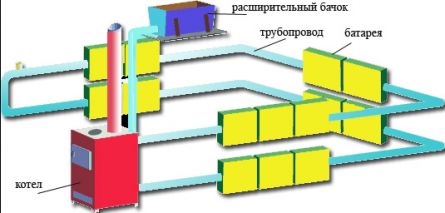
Scheme of water heating of a private house
Water circulation is supported by a circulation pump. The water heating system is a closed circuit consisting of a heat generator boiler, a pipeline, and batteries. Water or antifreeze is constantly circulating through it. The fuel for heating the boiler can be coal, firewood, natural gas, kerosene, etc .; centralized power supply or alternative power: solar and wind converters, mini-hydroelectric power stations, etc.
In addition to the boiler, pipes and batteries, the water heating system includes devices for adjusting the system: an expansion tank, where excess water or antifreeze arising during heating is discharged; thermostats, circulation pump, pressure gauge, shut-off, automatic air vent, safety valves.
Table 1: Selection of boiler power depending on the heated area of the house

For an area from 30 to 1000 sq. meters, you can also use electric boilers with a capacity of respectively 3-105 kW. Restrictions on the use of electric boilers may be for the following reasons: there is not always enough power supplied to the house, the high cost of electricity, taking into account the cost of 1 kW of energy per 10 sq. M. with ceiling heights up to 3 m, possible power outages.
![]()
Diagram of the water heating system of a private two-story house
Pipes made of different materials are used in the water heating system:
1.Steel, steel galvanized, stainless;
During installation, they are welded.Steel pipes have a significant drawback: low corrosion resistance. Galvanized and stainless steel pipes do not have this drawback; it is advisable to use threaded connections in their installation. When assembling a pipeline from metal pipes, skill and qualifications are required. At present, such pipes are used less in new construction of cottages.
2. Copper;
Copper pipes are reliable, withstand very high temperatures and high pressures. They are connected by high-temperature soldering with silver-containing solder. They can be hidden in the walls of the house with subsequent embedding. Working with such pipes requires high qualifications. Copper pipes are the most expensive of all, and are mainly used in exclusive construction.
3. Polymer(metal-plastic, polyethylene, polypropylene reinforced with aluminum).
Polymer pipes are convenient for installation and do not require special professional qualities of the assembler. Reinforced-plastic pipes (aluminum is covered with plastic on both sides), durable, resistant to corrosion, do not allow sediment to be deposited on the inner surface. Reinforced-plastic pipes are mounted using press or threaded connections without the use of welding, which reduces the cost of installation work. However, they also have a drawback: a large coefficient of thermal expansion. If only hot water went in the pipe for a long time, and then cold water went, then they can leak. Therefore, a temporary shutdown of the boiler in winter and defrosting of heating systems leads to irreversible damage. Another reason for a possible leak: if you bend it at an acute angle, then the aluminum layer may simply break.
The choice of material for pipes should be coordinated with the designers, taking into account the possibility of alternative or "emergency" heating of the house, as well as your material capabilities. Experts point out that almost the only way to get an absolutely reliable system is to use a copper pipeline that will last more than one generation.
Hot water heating system
The water heating system can be single-circuit and double-circuit. The single-circuit system is intended only for space heating. A two-circuit system is created both for heating and for heating water for domestic needs. Two single-circuit systems are often used, one of which is responsible for heating, the other for heating water, then in the warm season only one system can be used, taking into account that 25% of the boiler's power is spent on heating water for domestic needs.
There are three options for indoor pipe routing: one-pipe and two-pipe, collector. Two-pipe heating systems are considered optimal for individual houses.
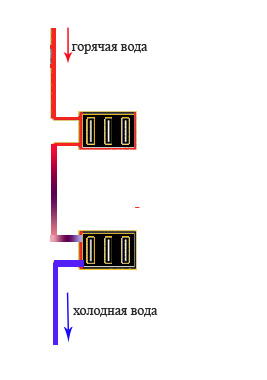
One-pipe wiring of water heating of a private house
The heated water from the boiler passes sequentially from one battery to another. The last battery in this chain will be colder than the first. This system is more often used in apartment buildings.
Note: It is difficult to control a system with a one-pipe wiring: without special techniques, it is impossible to block the access of the coolant to one of the radiators, since this will block access to all the others.
Indoor temperatures are easier to regulate if applied two-pipe wiring... With this type of wiring, two pipes are connected to each heating device: with hot and cold water. Such pipes can be star-shaped.
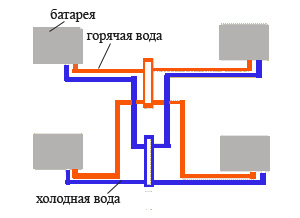
Scheme of two-pipe wiring for heating a private house
A pipe with hot water goes to the battery and leaves with cold water. The temperature of each battery is the same.
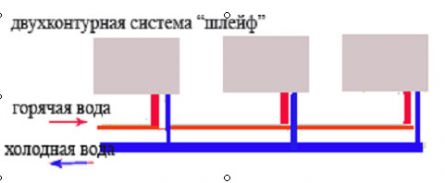
Diagram of a two-office loop system
In this case, the batteries located closer to the heat source are warmer.
There is also a radial or collector wiring, when two pipes are supplied from the collector to each heating device - direct and reverse.
Note: A collector in a water heating system is a device that collects a heating medium - water.
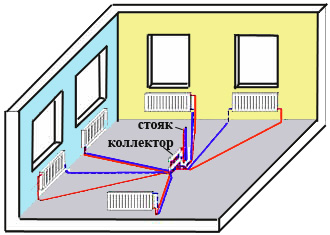
Collector heating scheme for heating a private house
Collector systems are universal, they allow you to make heating systems with hidden pipe wiring. Installation can be carried out by people without special skills. Such a wiring diagram makes it possible to regulate the system and the installation of special electric motors that maintain a given temperature in the rooms. The advantage is easy temperature control in each room, relative ease of installation, the ability to replace a damaged pipe section without destroying the floor structure. On each floor, in a special cabinet, there are collectors, from which pipes go to the heating radiators, independently connected to each radiator. All shut-off valves are located in the cabinet. The need to install cabinets and the high costs of pipes are among the disadvantages of the manifold system.
Note: The cost of pipes will depend on the selected wiring scheme (two-pipe or one-pipe). The one-pipe scheme has a lower cost price.
Calculation of the cost of a heating water system
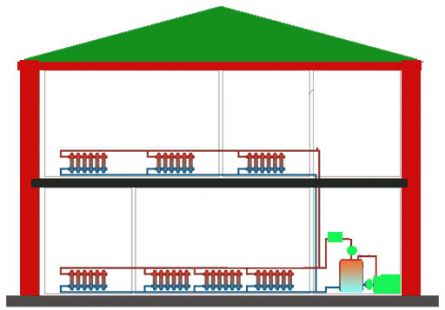
Heating water system calculation scheme
It is believed that for heating a room with an area of 10 sq. M. you need 1 kW of heating power.
There are also correction factors:
From 2 windows facing north - 1.3;
From 2 windows facing south and east - 1.2;
1 window facing north or west - 1.1.
Example: Area 10 x 10 sq. M, two floors. 4 rooms with 2 windows each.
Based on the footage, you need a 25 kW single-circuit boiler (for example, it runs on gas) or a 28 kW double-circuit boiler for heating domestic water. On average, such a boiler can cost about $ 800. You can also choose an electric boiler, which can also cost about $ 800-850 for a house of such an area.
Equipment:
- batteries (choose steel: 8 batteries on the first floor, two under each window, size 500x800, power 1645 W; and 4 batteries on the second floor, one under the window, size 600x1000, power 2353 W);
- polypropylene pipes about 200 m;
- brackets;
- corners;
- taps and other elements;
- installation of the system;
- system design;
- approvals will be about $ 11,000.
If you need a gas supply for a gas boiler, you need a project with approvals, which will cost about $ 400. Then it is necessary to lay a gas pipeline, which can cost about $ 1,500. When choosing an electric boiler, costs are reduced due to the fact that additional wiring is not required (unlike gas boilers), respectively, a chimney and a boiler room are not needed.
Note: hot water heating systems have a disadvantage such as time-consuming and expensive installation, the need for preventive maintenance. If antifreezes are used in the system, then it must be remembered that all antifreezes can lead to leaks in the system, after five years, antifreeze change is required, as they age, and their freezing point rises.
Air heating
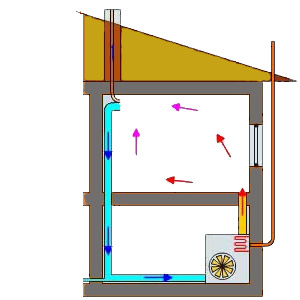
Air heating scheme in a private house
Air heating systems are gravitational and forced ventilation systems. With a gravitational heating system, air moves by natural circulation due to temperature differences. At different temperatures, there is a different density of air, due to which there is a natural movement of air in the system.
Warm air goes out through the air ducts under the ceiling and, occupying a significant volume, displaces colder air (for example, near windows and doors) down and towards the air intake, thereby creating air circulation in the heated room. The disadvantage of gravitational (natural) circulation) is that due to the flow of cold air from open windows, doors, drafts, air circulation is disrupted and overheating occurs in the upper part of the room and cooling of its working part. The advantage is independence from electricity.
A forced ventilation system uses an electrically driven fan to increase air pressure and distribute it to ducts and rooms. The carrier of heat is air, which is heated by a heat generator, the main elements of which are a burner and a heat exchanger. The air blown by the fan blows the heated the heat exchanger, where the combustion products exit, heats up to 45-60 degrees, then is fed through the air duct system to the rooms. The cooled air is returned to the heat generator via return ducts or grilles. The speed of air movement in systems with forced circulation is much higher. But there is a problem of noise in air ducts and distribution grilles.
The air heating system makes it possible to do without boilers, radiators, pipes and other elements that are used in water heating. Heat generators can operate on different types of fuel from the burner.
The principle of operation and the structure of the system:
The rooms are heated by supplying heated air there. The system works in full automatic mode. The main element of the system is a heat generator. Heat generators can be both stationary and mobile.
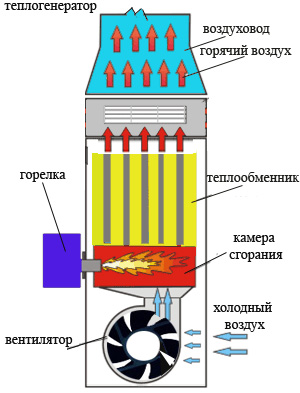
The design of the heat generator for the installation of an air heating system
In the combustion chamber of the heat generator, liquid fuel (diesel, kerosene) or gas supplied from the burner burns (gas and diesel burners have standard dimensions and connections, therefore they are interchangeable). With a diesel burner, an additional tank, filters, fuel lines for liquid fuel are needed. Household gas heat generators can operate both on natural main gas and on bottled liquefied propane-butane.
Note: heating of a residential building with an area of 100 sq. meters within a month at a temperature of + 24 degrees C, approximately 6 fifty-kilogram cylinders of liquefied propane will be required. Alternative to cylinders: propane tanks (sizes 2500-5000 liters) - gas tanks buried in the ground, they do not require special heating).
A fan is located at the bottom of the combustion chamber; air from the room enters here, which is directed to the heat exchanger (heat generators can also carry out a small admixture of street air). Further, the heated air is directed through the air ducts into the room, and the combustion products go into the chimney. Heated (usually up to 45-60 degrees) and injected directly or through air ducts, moving, creates uniform heating throughout the entire volume of the room. Air is returned to the heat generator via return ducts or floor grilles. The exhaust gases are discharged through the chimney. To heat a house, an air flow rate of 1000 to 3800 m3 / h at a pressure of 150 Pa is sufficient.
With a large area of the room, long air ducts can lead to heat loss, therefore, sometimes it is possible to install several heat generators without air ducts instead of one heat generator with air ducts connected to it. The maximum length of the main duct should be no more than 30 m, branches - no more than 15 m.
Air ducts differ:
1. By form: round and rectangular;
Round air ducts usually have a circular cross-section with an inner diameter of 100-200 mm, they are durable, create little aerodynamic resistance. Fastened with a clampthe desired diameter and studs.
Rectangular air ducts in the form of boxes with dimensions from 100x150 mm to 3200x4000 mm. have advantages when a large cross-sectional area is needed, or installation is carried out in difficult conditions, they fit better into the interior of rooms, save space, therefore they are more often used in private houses. Fastened with a special profile and stud.
Both round and rectangular ducts are fixed to the ceiling with drop-in anchors.
2. By hardness: tough and flexible;
Rigid ones are made of galvanized or stainless steel (cross-section and round and rectangular). They are used in rooms of any layout and complexity. Flexible and semi-flexible air ducts of only circular cross-section are made of thermoplastic material using a spiral steel frame. They are convenient for installation, however, the aerodynamic resistance increases.
3. By material: metal and non-metallic;
Metallic:
- Chimneys are made of black steel (1.0-2.0 mm) with a primer;
- Air ducts are made of copper in wet rooms: kitchens, bathrooms, bathrooms, swimming pools. This is the most expensive material;
- Made of aluminum alloys: able to withstand high temperatures, do not corrode. More often installed in kitchens;
- From galvanized steel or stainless steel: produced with a thickness of 0.5-1.0 mm. Such air ducts have a low price, they have anti-corrosion properties, durability and increased fire resistance. (Galvanized steel air ducts are used most often).
Non-metallic:
- Plastic air ducts are low cost, made of polyethylene, vinyl plastic, etc. They are light in weight, easy to install, do not corrode, and have antistatic properties. However, they have low fire resistance. Attached with metal or plastic mounting brackets.
- Textile air ducts for air transportation are made of airtight polyamide fabric, and for air supply, permeable polyester fabrics are used (they are also an air filter). To ensure fire resistance, fiberglass is used. They are economical, easy to transport, easy to attach and assemble. However, the textile air ducts only provide air flow.
Air ducts passing through unheated rooms or adjacent to an external wall must be thermally insulated. If you plan to hide the air duct between the ceilings, then you need to place it in a metal frame and insulate it. In order to disinfect the air and refresh it, filters, humidifiers and air fresheners can be built into the system. Air diffusers and air intake devices are attached to the ends of the air ducts that go into the premises.
Calculation of the cost of an air heating device

Scheme for calculating the heating air system
Example: two-storey private house with an insulated attic and a basement with a total area of 300 sq. meters. Equipment and ducting will cost approximately $ 8,000; consumables will be $ 550. (pipes and air duct routing will cost $ 10-15 per r / m). Installation and commissioning works -2300 $. Design and estimate work - $ 700.
In general, air heating without automation can cost about $ 11,000. Some firms offer the cost of air heating installation 26-36 USD. for 1 sq. turnkey meter. Comparing these calculations with the calculations of water heating, it can be seen that the cost of wiring air heating, calculated at a minimum, will be lower than when creating water heating. Thanks to the automation, the air heater can be turned on 3-4 times a day for 10-15 minutes to maintain the temperature. Fuel consumption during the heating season can be lower by 30-40% compared to hot water heating.
The disadvantages of air heating include the fact that it is difficult to carry out its modification, it requires a competent calculation of air ducts and network topology, labor-intensive routing of air ducts, and the installation must be carried out during new construction. It is necessary to condition and humidify the air in the room.
Electric heating
Among the various options for electric heating of private houses: electric convectors, ceiling infrared long-wave heaters, cable and film systems for floor and ceiling heating.
Consider the use of electric convectors. They are popular in low-rise suburban construction, especially in those regions where there are no gas mains.
The principle of operation of electric convectors
The operation of the electric convector is based on the phenomenon of convection (circulation) of air, as a result of which more than 80% of the heat is released into the air. High moisture resistance and reliability of convectors allows them to be installed in bathrooms and children's rooms, since the temperature on their surface does not exceed +60 C. There are models of electric convectors that do not dry the air in the room and do not burn oxygen. The operation of electric convectors is based on heating the cold air entering the device from the room. Heating is produced by a heating element made of a conductive component. After heating, the air increases in volume and rises up through the louvers of the outlet grille. In addition, the air is heated due to the radiation of heat from the surface of the electric convector.
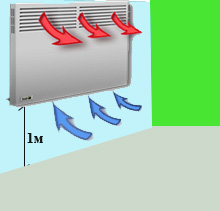
The scheme of the electric converter
The comfort level is ensured by an electronic temperature control system. There are models with a built-in thermostat, and with a remote thermostat. The thermostat saves energy. The air temperature sensor records the temperature in the room with a short period of time and sends a signal to the thermostat, which turns on or off the heating element. The presence of a thermostat allows you to set the operating mode once, and disconnect the device from the network only for a long absence. The built-in thermostat is influenced by the temperature of the convector body, therefore its data may be inaccurate. The remote thermostat regulator takes into account the temperature of the point in the space where it is installed. The remote thermostat is attached to the wall at a height of 1-1.5 m from the floor, away from drafts.
Electric convectors can be divided by size into two main groups: high - up to 45 cm high and baseboards - up to 20 cm high. High convector convectors are either placed on the floor or fixed to the wall using a special frame. Skirting convectors are convenient for installation under low windows, stained-glass windows. Their power is 0.5-3.0 kW (in 250 W steps). Dimensions in length, depending on the power, can be up to 2.5 m with a thickness of about 80 mm. For the greatest effect, the electric convector is recommended to be installed at a height of up to 1 m, or under window openings. To ensure normal air circulation, do not obstruct the electric convector with objects at a distance of up to 0.1 m.
In terms of operating costs, this type of heating loses only to gas, but it is more reliable and safe. Overheating protection is provided in the control units. No grounding required. The devices are insensitive to voltage surges. The voltage in the network is sufficient for the operation of the device - 220 V.
Calculation of the number of electric convectors
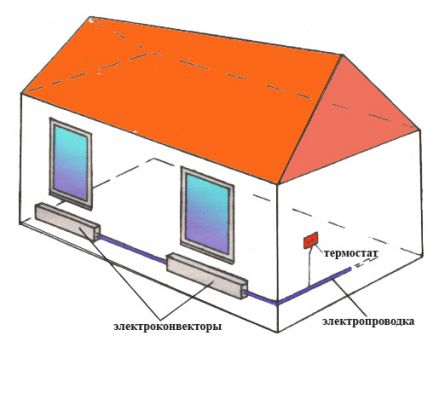
Diagram of the number of electric converters in a private house
The number and power of convectors are determined based on the volume of the room to be heated.
The calculation can be based on the required power for heating 1m3 of premises: 20 W / m3 - for premises with good thermal insulation (according to energy-saving standards of the Scandinavian countries); 30 W / m3 - houses with insulation of walls and ceilings, double-glazed windows on the windows; 40 W / m3. - poorly isolated houses; 50 W / m3 - poorly insulated buildings.
Example: The demand for the main heating of a house with an area of 100 m2 and a height of 3 m (volume 300 m3) of a weakly insulated house, that is, with a demand of 40 W / m3, is 12,000 W. Thus, four convectors with a capacity of 2.5 kW and one with a capacity of 2.0 kW can be placed on this area. Depending on the company and the availability of additional functions, the price of the convector can be from $ 100 to $ 200-250. Thus, the cost of electric convectors for this case (seven pieces) can be $ 1250.
To the advantages of electric convectors can be added the fact that with the overall low cost of equipment, there are no costs for maintenance and prevention.
Note: The disadvantage of electric convectors is that they heat up the room unevenly in height: warm air accumulates under the ceiling, and at the floor the air temperature remains low, which is also characteristic of water heating; dependence on electricity can also become problematic when it is turned off; in addition, the circulating streams carry dust with them. However, now some companies offer models of electric convectors, which help to reduce the collection of dust around the devices. If the room is large, a fan should be installed to speed up heating.
How to choose the type of heating for a private house
Based on the experience of various construction projects, it is safe to say that the most correct choice of a heating system for a particular house depends on what type of energy is most available, the remoteness of the dwelling from settlements, and the material capabilities of the owner. In any of the heating systems there are pros and cons, so before making a decision, consult with the designers.
Of course, if there is a gas supply to the house or even to the area, then it is best to choose water heating with a gas heat generator (boiler). Gas is currently the cheapest form of energy. However, in winter, gas pressure drops to 100-120 mm of water. Art., at a rate for boilers of 180 mm of water. Art., which can lead to shutdown of the heating system.
For heating, you can use electric convectors. If it is possible to supply electricity of sufficient power (if you have installed equipment with a capacity of more than 10 kW, you need to connect a three-phase wire and agree with the power supply authorities), then you can use other types of electrical heating. However, then you will be completely dependent on the power supply.
Owners of houses remote from civilization will have to think about creating an independent heating system.
For example: devices in the house of stoves, solid fuel fireplaces. The main danger in case of improper installation of stoves: the possibility of carbon dioxide entering the room, therefore good stove-makers are needed. As an alternative to stoves, you can supply a solid fuel boiler: wood and coal for hot water heating. With the device of sensors, such boilers will be able to maintain the desired temperature without the participation of electricity. Or use boilers on liquid fuel, however, taking into account that emissions from burning diesel fuel are harmful to health, and also that 1 kW of energy will cost 4-5 times more than when using solid fuel.
In order to be sure that your home will always be warm, it may be worth making sure that you can use different sources of energy. For example, to have a solid fuel fireplace or purchase a boiler that runs on different types of fuel, which is produced by European manufacturers, however, its price will exceed the total price of single boilers operating on different fuels.
The most important characteristic of current costs is the cost of fuel and its consumption per unit of time.
Currently, fuel prices are approximately:
1 liter of diesel fuel - $ 0.4. The cost of 1 kWh of energy is $ 0.04.
1 m3 of natural gas for a private trader - $ 0.04. The cost of 1 kWh of energy is $ 0.005.
1 liter of propane-butane mixture - $ 0.2. The cost of 1 kWh of energy is $ 0.018.
1 kWh of electricity for a private trader - $ 0.03.
1 kg of coal on average $ 0.2. The cost of obtaining 1 kWh of energy ($ 0.04).
Attention! All prices in this article are for the 2009 period.



